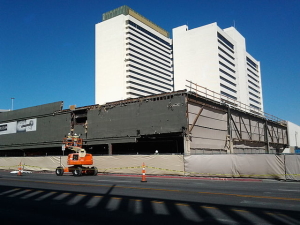EB-5 Immigrant Investor visas are a hot topic for Congress this month, as the program needs to be reauthorized by September 30 to continue. The foreign investment program has been popular since it began in 1990, allowing businesspeople from other countries to gain visas into the United States as long as they invest money and create a certain number of jobs.

Construction to transform the Lady Luck Hotel & Casino to the Downtown Grand Las Vegas (funded by EB-5 investors), courtesy of Wikipedia user Wtstoffs, CC BY-SA 3.0.
Last year, more than 85,500 jobs were created by investors who also were each required to inject $500,000 into a business to receive an EB-5 visa. The investments brought an additional $5 billion into the United States. Investors also are able to bring their families into the country and establish permanent residency as part of the EB-5 program.
In recent years, China has been the number one country sending investors to the United States. In 2014, of the 10,692 EB-5 visas that were issued, more than 9,100 were given to Chinese entrepreneurs. It comes as no surprise that Chinese businesspeople are looking for ways to emigrate to the United States. China is the second-largest economy in the world, and analysts see it continuing to slip as debt, low interest rates, and a shaky stock market keep investors on edge. The market turmoil has caused increasing numbers of Chinese investors to look outside their country for more optimistic business opportunities.
Cities across the country have felt an economic boost from the EB-5 program. A wide range of businesses have been created with the promise of news jobs as well as an influx of cash into the local economy. In California, cities like El Monte have enjoyed the benefits of EB-5 investors, often in coordination with EB-5 regional centers that pool those investments. New businesses such as hotels are popping up, thanks to the EB-5 program. In a city where loans are sometimes difficult to get, the EB-5 program opens doors that might not otherwise be easily opened.
With all the good that has come from the EB-5 program in the last quarter century, it may seem strange that Congress has not already authorized it to continue. However, fraud has been a well-publicized problem causing headaches for many of those involved.
In El Monte, plans were set up with an EB-5 regional center for development of a shopping center and housing development. Things were going well until the developers were arrested on suspicion of fraud. Although the developers were not prosecuted, the City backed out of the plans after the arrests, and the developers sued in response.
It wasn’t the only report of fraud. A report by the Brookings Institution noted that while the EB-5 program has boosted the economy, a lack of oversight has caused situations like the one in El Monte and raised concerns by some legislators.
While there have some problems, Congress is already looking for ways to make sure the EB-5 program continues and is better at protecting both investors and the communities they serve. The Brookings Institution report recommended setting up an oversight committee to guard against fraud. A bill introduced by Senators Patrick Leahy (D-VT) and Chuck Grassley (R-IA) would increase the power of the Department of Homeland Security to investigate investors and regional centers to ensure that projects follow the letter of the law. The bill would also raise the minimum investment level to $800,000 and update the definition of Targeted Employment Area so more investments go to locations with high unemployment or rural areas.
We’ll have more on the EB-5 program and the results of the proposed legislation in the coming weeks.






Recent Comments